|
|
| Who was Sam Niver? | |
|
|
|
|
A modest, rural upbringing The Niver house was just outside the city limits, so Sam and his sisters attended a one-room schoolhouse in their early years. He spent much of his summers "on the lease" with Sam Sr., helping out and enjoying a thoroughly rural upbringing. "All of us learned to fish and swim in the creek," he said, aka the Conewango River that ran a few lots behind their home. They also hiked the countryside, climbed Gardner's Rocks, sledded in winter, and got into plenty of youthful mischief, to hear Sam tell it. Like most of America, the Nivers hit especially hard times during The Great Depression. Sam's father lost everything: He came a few dollars short of raising enough money to bid on and buy the oil leases that were his living. Sam always claimed that his dad's hair "turned snow white" in a matter of days. |
 |
|
World War II was a jungle Sam wasn't long out of high school before Uncle Sam called him to service. When he had tried to enlist earlier, bad teeth and eyesight got him rejected. But in wartime, any "warm body" would do, he wrote years later. "Little did I know the government didn't care if I couldn't see or bite the enemy." |
|
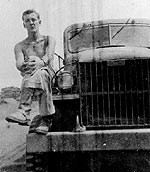 |
Sam was assigned to Chemical Warfare and shipped out to the China-Burma-India theater. He spent more than two years as a Tech Sergeant in the dense jungles of Assam, India, minding (and ultimately burying) a cache of mustard bombs. His experience in the military left Sam with a healthy dose of skepticism and firsthand knowledge of what SNAFU stands for. After the war, he returned home knowing that his sweetheart, Karla Svendsen of nearby Jamestown, NY, had married in his absence. Fortunately, she was an identical twin, so Sam resumed romance with her sister, Anna, and they were married within a year. |
|
College, marriage and a career The young couple moved to Northeast Ohio so he could enroll in journalism at Kent State University, courtesy of the G.I. Bill. They lived modestly in a trailer park, and Anna (nicknamed "Sweeny") took some classes but never graduated. Decades later, Sam choked up when he talked about going to college. "I'll always thank Uncle Sam. He paid my way. I never could have gone otherwise," he said. After graduating, Sam went to work as editor of a small weekly newspaper in Rittman, Ohio, then to another paper in the Cleveland suburb of Maple Heights. It was virtually a one-man operation, except that Sweeny handled the bookkeeping. A short time later the publisher bought another weekly in nearby Bedford, and Sam moved there to become general manager of both papers. |
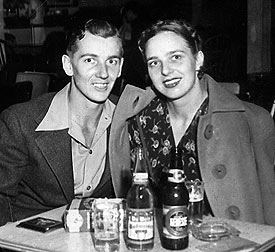 Sam & Sweeny |
|
Now he hired editors, instead of being one, and could focus primarily on advertising. Sam was a consummate promoter whose creative experiments often dovetailed with the civic sector. One of his ideas, Swap 'n' Shop, turned Main Street into a public, open-air flea market. Sam organized downtown merchants (BBB Stores – Buy Better in Bedford), city car dealers (into what may have been the first-ever Auto Mile), and was a fixture as a barker at the annual Lion's Carnival on the town square. Parties in the Park and an annual Rib Burn-Off were other ideas that took hold and still survive long after Sam. For Bedford's celebration of America's Bicentennial, Sam organized and chaired a committee that worked more than two years to raise money for a new community park. As part of the '76 activities, he enticed the mayor of Bedford, England, to visit his sister city here, gaining national exposure in People Magazine. Sam was rich in friends, if not income, and was always his own boss. He could eat lunch at home, and in retirement he told friends and family: "I looked forward every morning to going to work. How many people can say that?" |
|
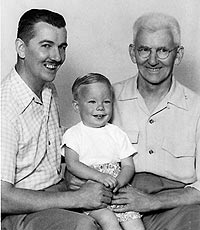 Three Generations of Samuel Jay Niver |
Family vacations discover Topsail Island Sam and Sweeny had three children. The first were twins (Gretchen and another Samuel Jay) who arrived in 1952, and the third was a son, Teigh, born in 1958. As soon as they were old enough to travel, the kids were treated to an annual camping vacation in the family station wagon. Excursions were as close as Pennsylvania, as far as Wyoming, but usually somewhere comfortably in between. One year in the early '60s, the clan went to North Carolina and discovered Surf City Family Campground on Topsail Island. It was the beginning of a lifelong love affair, as the family returned repeatedly and the siblings continued as adults (though tents gave way to cottages). |
|
Sam and Sweeny loved the beach – surf fishing, sunning, feeding gulls, collecting shells, and leaving Great Lakes winters behind. It was no surprise when, in 1980, they pre-bought a unit in the island's first beachfront condos. They planned to retire there, but didn't wait to move south. In 1984 son Jay found a weekly newspaper for sale near the beach and invited his parents to join him in a family business venture. They did, leaving 27 years of friends and activities behind in Ohio. At their new paper, Sam handled advertising, Sweeny did the books, and Jay produced the copy. The adventure lasted two years, until Jay moved away to follow his wife's career. The paper was sold, and Sam and Sweeny were now retired. |
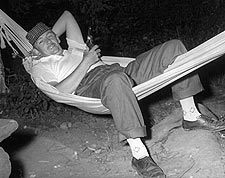 Sam in vacation repose |
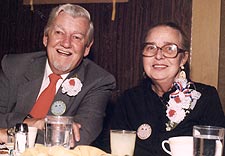 Sam and Sweeny - Retirement |
Retirement and an inland move The couple became almost full-time "beach bums," with Sweeny active in the historic society, Sam dabbling on the computer, and both in the volunteer fire department (which certainly brought confidence to the populace). Sam launched a brief but prolific writing career, first with a newsletter for friends and family, then with regular columns in the Warren Times-Mirror. More than 100 articles later, he published his own collection of humor, commentary and recollections (Of Cabbages and Kings). |
|
Sam also jumped headlong into an island incorporation drive, but living on the beach wore thin after 11 years. Sam had a bout with skin cancer, so could no longer spend hours in the sun. Sweeny was becoming less ambulatory, so could no longer stroll the beach. What's more, in advancing age they didn't like living next to the community pool, chock full of screaming kids (during the day) or drunken Camp Lejeune Marines (after closing). In 1995 they moved "inland" to rent their son and daughter-in-law's newly purchased second home, on a Sneads Ferry bay off the Intracoastal Waterway. By then, Sam had been diagnosed with prostrate cancer, but he would still enjoy surprising years of relatively good health. A family pinnacle was reached in June of 1996 when Sam and Sweeny celebrated their 50th anniversary. Family and N.C. friends gathered on their deck overlooking the water. It was the same deck where Sam died two years later, 17 months after Sweeny had died in a local hospital. |
|
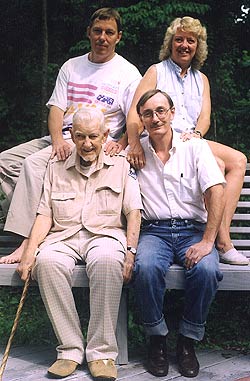 The Final Family Photo |
|
|
|
|
All Material Copyright © 2003 Live And
Let Go Productions, LLC |